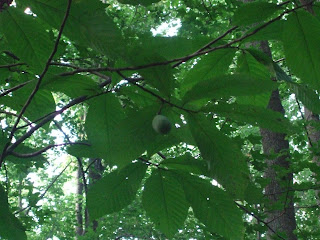As part of my Granddaddy nature lore, I remember what a Pawpaw tree looks like. I see them now and then in lush native forests like the one behind Granddaddy's house. They're spindly things, ranging in height from six to 30 feet. The leaves are the kind I used to draw as a child: elongated ovals, longer than an adult's hand.
About a month ago, the boys and I were hiking in Elk Neck State Park and the underbrush was made of pawpaw trees. I'd never seen so many. Glancing up at the underside, I saw the beginnings of fruit and I wondered if there were still pawpaws in Granddaddy's woods.
 Last Thursday, Granny and I were talking about Granddaddy and his love for the natural world. She told me he'd learned from his father and would bring her not just pawpaws, but wild blackberries and a nut-type fruit called chinquapins. Neither of us had any idea what a chinquapin was and lamented the lost knowledge.
Last Thursday, Granny and I were talking about Granddaddy and his love for the natural world. She told me he'd learned from his father and would bring her not just pawpaws, but wild blackberries and a nut-type fruit called chinquapins. Neither of us had any idea what a chinquapin was and lamented the lost knowledge.After dinner, determined to pass on my meager knowledge, the boys and went into the woods behind the shed.
Lo' and behold. . .

Pawpaws with a little baby fruit.
They should be ripe September/October. Who's game?
------------------------
For more information:
Kentucky State Pawpaw Program
http://www.pawpaw.kysu.edu/
"The Pawpaw Patch," Watersheds.org
http://www.watersheds.org/nature/pawpaw.htm

No comments:
Post a Comment